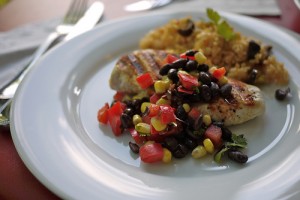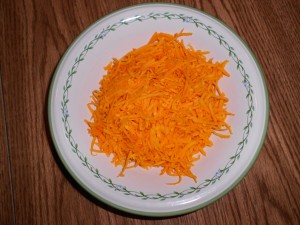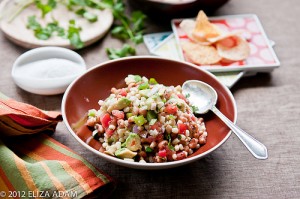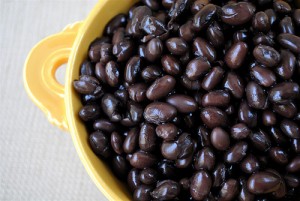One skill you’ll want to learn on the low oxalate diet is how to modify recipes to reduce their oxalate content. In this series I will take you through the steps I follow when I modify recipes for my family. If you missed the first installment, please read Modifying Recipes for the Low Oxalate Diet: Is this a Low Oxalate Recipe? Then get ready for today’s lesson: simple low oxalate substitutions.

Grilled chicken, Spanish rice and Santa Fe black bean salad -- Perfect . . . except for those really high oxalate black beans! It's time for some good low oxalate substitutions.
The big question of course is “When is it okay to directly substitute a low oxalate ingredient for a high oxalate ingredient, and when will it mess up my recipe?” To answer this question you first need to ask yourself some other more basic questions.
Before using low oxalate substitutions, ask:
1.) What role does the high oxalate ingredient play in this recipe? In other words, does this ingredient mostly offer flavor (such as a spice)? Does it act as a binder? Does it act as a catalyst for an important chemical reaction in baking? Does it offer bulk? Is it the main ingredient? Does it offer color or crunch? Does it offer superior nutrition? Does it add authenticity to a cultural recipe? If you want your low oxalate substitution to work, the substitute must fulfill the most important roles the original high oxalate ingredient plays in the recipe (and hopefully a few of the minor roles, too).
2.) Would the recipe still work if I omitted the high oxalate ingredient? In other words, how important is the high oxalate ingredient in the recipe? Sometimes it’s better to omit high oxalate ingredients instead of using low oxalate substitutions. Other times it’s better to use low oxalate substitutions, but in reduced amounts. If an ingredient isn’t that important, I often leave it out instead of trying to find a substitute.

Shredded carrots, right? Wrong! This is shredded butternut squash -- a fabulous low oxalate substitute that can be used in any recipe that calls for shredded carrots. It's even orange, and it gets squishy and sweet when cooked--perfect!.
3.) Are there any good medium or low oxalate substitutions available for this ingredient? To be a good substitute, the low oxalate ingredient must fulfill all of the important roles the original ingredient plays in the recipe, and hopefully some of the less important roles. Some high oxalate ingredients have plenty of good low oxalate substitutes. Depending on the role carrots play in a recipe, butternut squash, pumpkin, acorn squash, zucchini, cauliflower and even chopped broccoli stalks may be a good substitute. For other high oxalate ingredients, your low oxalate substitutions may be limited or don’t exist. Whole wheat flour in a whole wheat bread recipe doesn’t have a good substitute, although white flour in gravies does (corn starch). If you aren’t sure what might make a good substitute, check out the last column in your low oxalate food list from the Trying Low Oxalate Yahoo Group (If you don’t have a list yet, please see How to get an Accurate Low Oxalate Food List). Karla, chef extraordinaire and keeper of the master list, has included some good low oxalate substitutions for common high oxalate ingredients in the last column of the list. Also, stay tuned to Low Oxalate Info — I’ll slowly be introducing you to my favorite low oxalate substitutes along with some sample recipes over the next few months. I sure love finding a new, good low oxalate substitute!
4.) Is your new recipe low oxalate or lower medium oxalate? Just because you substitute a low oxalate or medium oxalate ingredient for a high oxalate ingredient, doesn’t mean your new recipe will automatically be low oxalate. Sometimes even the best substitutions won’t do enough to lower the oxalate content of a recipe. Other times, you may have to chose the lowest oxalate substitute available, not necessarily the best substitute.
5.) Does the low oxalate substitute require special low oxalate cooking techniques that will mess up your recipe? For example, you can substitute dino kale and turnip greens directly for spinach in almost any cooked recipe, but in most cases these ingredients should be boiled before using (and the boiling water thrown out). Some recipes can easily accommodate this change. If you are planning to add dino kale to your lentil soup instead spinach, it’s easy to boil the kale first before adding it to the soup pot even if the soup recipe doesn’t call for the “spinach” to be boiled. On the other hand, it’s not as easy to use turnip greens in a spinach meatball recipe where the chopped “spinach” is supposed to cook inside the meatballs. You could boil the turnip greens first of course, but then do you let them cool? How do you mix the cooked turnip greens into the raw meat with out making a bunch of green, meaty mush? Will it change the taste or texture of the finished product? These questions aren’t simple to answer, and might take some experimentation.
Low Oxalate Substitutions in Action:
Next, we’re going to work through a recipe together so you can see how low oxalate substitutions work. Today’s lesson is the simple substitution, so this one may seem . . . well, simple. But don’t worry. I’ll tackle more complicated substitutions in further installments of the series.
Today’s featured recipe is Santa Fe Black Bean Salad. It was a favorite from my pre-low oxalate diet and vegetarian days (although I admit I usually made it with pinto beans instead of black beans!). I’ve listed the ingredients below with the total oxalate value for each ingredient in parenthesis next to it. (Note: all oxalate values in this recipe were tested by the Autism Oxalate Project or the Vulvar Pain Foundation).
Santa Fe Black Bean Salad
1 red pepper (about 1 cup) (3.6 mg.)
2 cups cooked black beans, rinsed (248 mg.! Holy Guacamole!)
1/2 cup fresh corn, cut off the cob (0.7 mg.)
1/4 cup chopped fresh cilantro (1.4 mg.)
3 cloves garlic (about 0.9 mg.)
1/2 teaspoon Celtic sea salt (o.8 mg.)
2 tablespoons extra-virgin olive oil (1.8 mg.)
Juice of one lime (about 2 tablespoons) (about 0.5 mg.)
1/4 teaspoon cayenne pepper (1.5 mg.)
As you can see, this salad has an obscene amount of oxalate. There was actually no need to calculate the oxalate values. By using the guesstimation method that I discussed in the first installment of this series, we know this salad isn’t low oxalate just by the presence of black beans in the ingredient list. Many low oxalate dieters might immediately dismiss a recipe like this, but if you look carefully, every other ingredient is low oxalate or very low oxalate. There’s really only one problem with this otherwise perfect recipe — those dang high oxalate black beans!
So, let’s ask ourselves the five questions above.
1.) What role do black beans play in this salad? — This one’s pretty easy. They’re the main ingredient. They also add bulk, protein, fiber, flavor, texture and a dark color that complements the bright hues of the vegetables and herbs. Plus, black beans are culturally important in Tex Mex and Mexican foods.
2.) Can the black beans be left out? — No way! We wouldn’t have anything left to eat but some over-dressed corn. And whoever heard of bean salad without beans?
3.) Are there any good low oxalate substitutes for black beans? — The first thing that pops into my mind are the medium and low oxalate beans, like kidney beans, chick peas, lima beans or black-eyed peas. Getting a little more creative, we could also use extra corn, extra red pepper or some other low oxalate vegetable like cauliflower or broccoli. It’s possible we could also use lentils or split peas if we could keep them from cooking into mush. The question is — which of these are actually good substitutions for black beans in this particular recipe (i.e.they fulfill the important roles black beans played in the original recipe and hopefully some of the minor roles, too)? The veggies might make a tasty salad, but it’s hardly a bean salad anymore, so those don’t qualify as good substitutions (although they may be worth exploring as a totally new recipe.) The lima beans seem more like a vegetable than a bean to me (and a mushy one at that), so I personally will veto those, although I admit they could work. Lentils, split peas and mung beans would probably be too mushy no matter how you cook them, and they don’t really have a “bean” feel to them, although again, I admit they might work. Kidney beans, black-eyed peas and chick peas definitely give you the bulk, protein, fiber, flavor and texture of a “real bean” without the mush factor. Dark red kidney beans get a bonus point because they would probably look pretty and appetizing in this salad. And black-eyed peas get a bonus point, too, because they most closely resemble black beans in size, texture and shape.
4.) Will the new recipe be low oxalate or lower medium oxalate? Here’s the kicker — kidney beans would probably taste great and look great in this salad, but at 11.1 mg. per half cup, they have too much oxalate to be the featured ingredient in any salad. You could double the corn, double the red pepper and halve the kidney beans, and it would work as far as oxalate is concerned, but this isn’t a simple substitution anymore (just something to think about if you want to get creative!). Chick peas are also too high in oxalate for this recipe, but black-eyed peas definitely aren’t. In fact, black-eyed peas are quite low in oxalate, and they fulfill every role that black beans play in the original recipe except they don’t look as pretty. They also aren’t as authentic for a Tex Mex or Mexican-inspired salad, although some Mexican cooks use them, as do many Tex Mex cooks, so I’ll give them a pass for cultural authenticity.
5.) Do they require special low oxalate cooking techniques that will mess up your recipe? No, black-eyed peas and black beans are prepared the same way — You soak them overnight (at least 12 hours), toss out the soak water, then cook the beans in water to cover for about 1.5 – 2 hours until they are soft. Cool your beans and they are ready to use in your salad.
So, we have a winner! Black-eyed peas! Here’s the full recipe with our changes – Enjoy!
Santa Fe Black Bean Salad

Santa Fe Bean Salad with chunks of avocado and some green pepper to add a little bit more color (this is still a low oxalate version with only a slightly higher oxalate content).
1 red pepper (about 1 cup) (3.6 mg.)
2 cups cooked black-eyed peas, rinsed (12 mg.)
3/4 cup fresh corn, cut off the cob (about 1.1 mg.)
1/4 cup chopped fresh cilantro (1.4 mg.)
3 cloves garlic, minced (about 0.9 mg.)
1/2 teaspoon Celtic sea salt (o.8 mg.)
2 tablespoons extra-virgin olive oil (1.8 mg.)
Juice of one lime (about 2 tablespoons) (about 0.5 mg.)
1/4 teaspoon cayenne pepper (1.5 mg.)
Combine the red pepper, black beans black-eyed peas, corn and cilantro in a large salad bowl and set aside. Combine the garlic, salt, and olive oil in a small bowl (or mortar) and smash it with a pestle or the back of a spoon until the garlic’s juices are well mixed with the olive oil and salt. Add the lime juice and cayenne pepper and mix well. Pour the dressing over the bean mixture and toss gently.
Makes about 8 servings (one half cup each).
Variations: Try roasting the red pepper first and cutting it into strips. YUMMY! See Low Oxalate Hummus for instructions on how to roast a red pepper. You might also want to add some chunks of avocado, green onions or a bit of green pepper to give the salad a bit more color (see the picture above).
Low Oxalate Info: Our newly modified Santa Fe Bean Salad has about 3.0 mg. oxalate per half cup serving. Not bad! (To get the oxalate value per serving, add up all the oxalate values in parenthesis to get the total oxalate. Then divide by the total number of servings (8), which in this case gives me 2.95 mg. oxalate per half cup).
Menu Planner: Serve Santa Fe Bean Salad with corn tortillas, Cilantro Lime Slaw, and sliced avocado for a yummy, Tex-Mex, vegan, low oxalate feast. One cup Santa Fe bean salad, one and a half cups cilantro lime slaw, one corn tortilla and half an avocado has about 14.2 mg. oxalate.
Other Diets: Santa Fe Bean Salad may also be appropriate for gluten-free, dairy-free, GFCF, sugar-free, vegan and vegetarian diets.
Photo credits go to Chip Harlan for Smoky Grilled Chicken and Black Bean and Corn Salad, to d06021stric for Black-Eyed Peas, to cookbookman17 for Black Beans, and to Eliza Adam for Black-eyed Peas and Corn Salad.


{ 3 comments… read them below or add one }